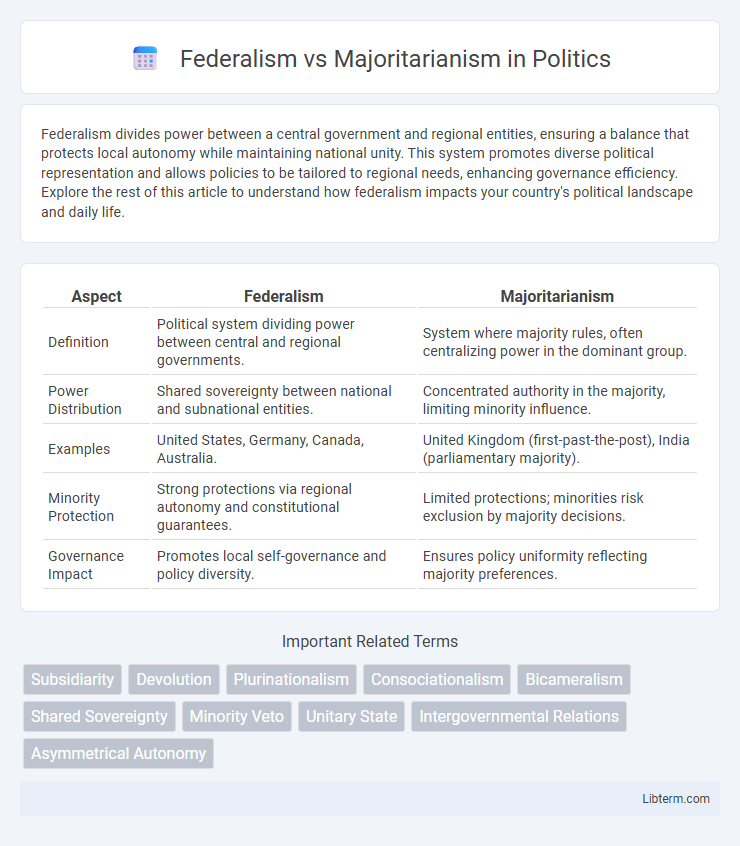Federalism divides power between a central government and regional entities, ensuring a balance that protects local autonomy while maintaining national unity. This system promotes diverse political representation and allows policies to be tailored to regional needs, enhancing governance efficiency. Explore the rest of this article to understand how federalism impacts your country's political landscape and daily life.
Table of Comparison
| Aspect | Federalism | Majoritarianism |
|---|---|---|
| Definition | Political system dividing power between central and regional governments. | System where majority rules, often centralizing power in the dominant group. |
| Power Distribution | Shared sovereignty between national and subnational entities. | Concentrated authority in the majority, limiting minority influence. |
| Examples | United States, Germany, Canada, Australia. | United Kingdom (first-past-the-post), India (parliamentary majority). |
| Minority Protection | Strong protections via regional autonomy and constitutional guarantees. | Limited protections; minorities risk exclusion by majority decisions. |
| Governance Impact | Promotes local self-governance and policy diversity. | Ensures policy uniformity reflecting majority preferences. |
Introduction to Federalism and Majoritarianism
Federalism is a system of government where power is constitutionally divided between a central authority and constituent political units, allowing for regional autonomy and diversity within a unified state. Majoritarianism emphasizes rule by majority, prioritizing decisions made by the largest group, often leading to centralized governance and potentially marginalizing minority interests. These contrasting frameworks shape political dynamics by balancing regional diversity against majority-rule principles in democratic societies.
Defining Federalism: Key Features and Principles
Federalism is a political system characterized by the division of powers between a central government and constituent units, such as states or provinces, ensuring a balance of authority. Key features include constitutional distribution of powers, autonomy of subnational entities, and mechanisms for resolving disputes between levels of government. Principles of federalism emphasize shared sovereignty, legal recognition of territorial jurisdictions, and cooperative governance to accommodate diversity within a unified political framework.
Understanding Majoritarianism: Core Concepts
Majoritarianism centers on the principle that the majority's decision holds supreme authority in governance, emphasizing the will of the majority as the foundation of political legitimacy. It prioritizes electoral majorities and often results in policies that reflect the preferences of the largest demographic group, potentially marginalizing minority interests. This approach contrasts with federalism, which distributes power across multiple levels of government to balance majority rule with regional autonomy and minority protections.
Historical Origins and Evolution
Federalism originated from early constitutional experiments like the 1787 U.S. Constitution, designed to balance power between national and state governments, promoting regional autonomy while maintaining unity. Majoritarianism evolved from democratic ideals rooted in ancient Athens, emphasizing majority rule as the foundation of legitimate political authority and policy-making. Over time, federalism has adapted to accommodate diverse populations and decentralize authority, whereas majoritarianism has faced challenges in protecting minority rights within electoral and legislative processes.
Structural Differences: Governance and Power Distribution
Federalism allocates power across multiple levels of government, enabling a division between national and regional authorities that preserves local autonomy and ensures shared governance. Majoritarianism centralizes decision-making power predominantly within a single dominant political group or institution, often resulting in top-down governance with limited checks from minority interests. Structural differences emphasize federalism's multi-layered institutional framework versus majoritarianism's concentration of power in a unified, majority-led government.
Benefits and Challenges of Federalism
Federalism offers benefits such as enhanced regional autonomy, allowing diverse communities to govern according to local preferences and reducing the risk of centralized authoritarianism. It facilitates policy experimentation and tailored solutions to regional issues, promoting more effective governance in heterogeneous societies. Challenges include potential conflicts between federal and state governments, complexity in law enforcement, and disparities in resource allocation, which can hinder national unity and policy coherence.
Advantages and Limitations of Majoritarianism
Majoritarianism enables decisive governance by reflecting the preferences of the majority, promoting political stability and clear accountability in decision-making processes. However, it risks marginalizing minority groups, potentially leading to social exclusion and undermining democratic pluralism. The limitation lies in its tendency to prioritize majority rule over inclusivity, which may cause polarization and weaken protections for diverse interests within a society.
Impact on Minority Rights and Representation
Federalism enhances minority rights and representation by distributing power across regional governments, allowing localized decision-making that respects diverse cultural, ethnic, and linguistic groups. Majoritarianism, emphasizing rule by the majority, often risks marginalizing minority groups, limiting their political influence and protection under uniform national policies. The balance between these systems critically affects the inclusivity and equity of democratic governance in pluralistic societies.
Federalism vs Majoritarianism: Case Studies and Examples
Federalism, exemplified by countries like the United States, Germany, and Canada, divides power between central and regional governments to ensure local autonomy and accommodate diverse populations. Majoritarianism, as seen in the United Kingdom and France, centralizes authority within a dominant party or group, often marginalizing minority interests. Case studies reveal that federal systems tend to promote political stability and protect regional identities, while majoritarian systems can lead to efficient decision-making but risk majoritarian tyranny.
Conclusion: Choosing the Right System for Diverse Societies
Federalism offers a decentralized governance structure that accommodates diverse cultural, ethnic, and regional identities, promoting stability and inclusiveness in pluralistic societies. Majoritarianism emphasizes majority rule, potentially risking marginalization of minority groups and social fragmentation. Selecting federalism or majoritarianism depends on the society's complexity, with federalism generally better suited for diverse populations seeking balanced representation and conflict mitigation.
Federalism Infographic

 libterm.com
libterm.com